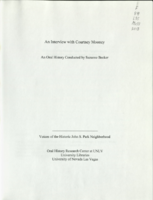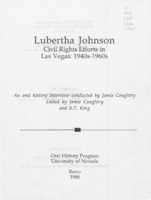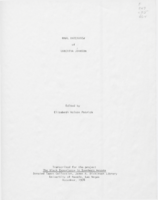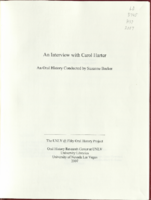Search the Special Collections and Archives Portal
Search Results
Mabel and David Hoggard oral history interview: audio clip
Date
Archival Collection
Description
Mabel Hoggard discusses how she came to live in Las Vegas and her employment history. She was on her way to Los Angeles and stopped in Las Vegas to visit relatives in 1944. She was offered a job as a secretary at the USO (United Service Organizations) and her relatives persuaded her to stay and live in Las Vegas with them instead of moving to California like she had planned. After working for the USO from 1944 to 1946 she applied to be a teacher. She had been a teacher before but lost her job because she refused to contribute part of her salary to a campaign fund. She faced some racially-based opposition when she first started teaching in Las Vegas but Maude Frazier advocated for her and the members of the school board renewed her contract after her first year, and she said she didn't "have any trouble" after that first year.
Sound

Transcript of interviews with J. David Hoggard, Sr. by Claytee D. White and an unnamed interviewer in 1997, 1998, and 1999
Date
Archival Collection
Description
Transcript of interviews with J. David Hoggard, Sr. by Claytee D. White, and unnamed interviewers in 1997, 1998 and 1999. Hoggard moved to Las Vegas in 1945 and became involved in civil rights through the National Association for the Advancement of Colored People and the Economic Opportunity Board.
Text
Audio clip from interview with J. David Hoggard, February 1, 1999
Date
Archival Collection
Description
In this audio clip, J. David Hoggard discusses the local chapter of the NAACP in Las Vegas and the Human Relations Commission.
Sound

Transcript of interview with Courtney Mooney by Suzanne Becker, July 30, 2007
Date
Archival Collection
Description
Courtney Mooney is the Urban Design Coordinator for the City of Las Vegas. Her job description includes a knowledge of historic preservation, which is her passion. In this interview she shares her professional and personal thoughts about John S. Park Neighborhood. She moved to John S. Park in 2002. As a professional she explains that "how I look at preserving neighborhoods or buildings, is more of a community preservation, not saving the individual building for the individual building's sake..." Courtney offers a big picture of the neighborhood's past, present and future. John S. Park, like so many other Las Vegas neighborhoods, was built during World War II and has been affected by history of segregation and the wave of changing demographics, and the work that went into the plan and requirements to be designated a historic neighborhood. Courtney provides a summary of the story about the land, its ownership and what lead to the foundation of the neighborhood: from John S. Park to George Franklin and John Law, to Mary Dutton and explains how the proposed development of the land differed from other communities being built to FHA standards and specifics that declared Las Vegas a Defense City in the 1940s. She lists the factors that made the neighborhood a logical and important target for the historic designation, a small neighborhood tucked away, that is "a snapshot of the types of people that were coming here," filled with community leaders, entrepreneurs, blue-collar and casino workers. She also mentions about the missed opportunity of the Las Vegas High School neighborhood for preservation while supporting the John S. Park designation.
Text

Transcript of interview with Lois Esther Tarkanian by Claytee D. White, September 24, 2014
Date
Archival Collection
Description
Jerry Tarkanian, legendary and formidable basketball coach, met his match the day he was called before student court at Fresno State College and had to face as one of his judges Lois Esther Huter. Lois, a no-nonsense military daughter, eventually agreed to date Tarkanian and to marry him. The City of Las Vegas got lucky when UNLV recruited Lois’s husband as basketball coach. After picking cotton in California’s Central Valley Lois earned her Master’s degree in speech pathology and holds national certifications in speech pathology, language, and audiology. In 1969 she opened California’s first private day school for the hearing impaired, Oralingua School for the Hearing Impaired in Whittier. In Las Vegas she taught hearing-impaired children in her home on an individual and pro-bono basis. In this interview Lois recalls her teaching career, debates in deaf education, her 12 years on Clark County School District School Board, and the people and the neighborhoods that make up Las Vegas’s Ward 1, the area she has represented on the Las Vegas City Council continuously since 2005.
Text

Edited narrative of interview with Lubertha Johnson by Jamie Coughtry, 1988
Date
Description
Edited narrative of an interview with Lubertha Johnson by Jamie Coughtry, dated 1988. Recalling her youth in Mississippi and move to Las Vegas, Johnson discusses civil rights, discrimination, and other topics between 1940 and 1970.
Text

Transcript of interview with Lubertha Johnson by Larry V. Buckner, February 10, 1978
Date
Archival Collection
Description
Interview with Lubertha Johnson conducted by Larry V. Buckner on February 10, 1978. Johnson moved to Las Vegas in the late 1940s from Mississippi and worked as a recreation director, nurse, and director of an anti-poverty progam, serving as a civic leader.
Text

Transcript of interview with Carol Harter by Suzanne Becker, April 20, 2007
Date
Archival Collection
Description
Carol Harter and her husband of 46 years started their married lives by running away from college in their sophomore year. They spent the 60's working toward their degrees. Carol earned her bachelor's in 1964 and her master's in 1967. One of her professors encouraged her to go for her PhD at a time when women simply did not aspire to such heights. Dr. Harter completed her PhD in 1970, and because her husband wanted to work on his doctorate, they moved to Athens, Ohio. She taught at Ohio University while he completed his courses. They lived and worked and raised their children there for 19 years. Carol held the positions of ombudsman (2 years), vice president and dean of students combined (6 years), and vice president at the university, and then accepted the position of president at SUNY Geneseo (in New York). Carol was nominated for the presidency at UNLV in 1994, and she accepted the job in 1995. Her career here has been phenomenal, as she saw the potential of this very young university and set about bringing in the faculty, the funding, the buildings, and the vision to create a first-rate research oriented facility. During her administration, the new library went up, the law school and dental school were built, and over 550 million in gifts and pledges were raised. This includes money raised for the "Invent the Future" campaign. Under Dr. Harter's guidance, women's sports were expanded, multiple graduate degrees were developed, more money for research and buildings was raised, and UNLV has become a major research university. Dr. Harter leaves behind a rich legacy, including her vision of the UNLV Midtown project, a cultural district where the university may one day interface with the community.
Text

Congregation Ner Tamid roundtable oral history interview: transcript
Date
Archival Collection
Description
Oral history interview with the Congregation Ner Tamid roundtable conducted by Barbara Tabach on September 21, 2016 for the Southern Nevada Jewish Heritage Project. In this interview, Rabbi Sanford Akselrad and five members of the congregation discuss the founding of Congregation Ner Tamid, the first reform synagogue in Las Vegas, Nevada, in 1974. They go into detail on how the synagogue was formed, the building-hopping they did until they built their current structure, and the funding it took to get to that point. The interviewees reveal a few donors, such as Morris Dalitz and Frank Sinatra, who helped to build their synagogue and school. The interview ends with meaningful stories and memories the members have relating to Congregation Ner Tamid.
Text

Transcript of interview with Jarmilla McMillan-Arnold by Claytee D. White, October 7, 2010
Date
Archival Collection
Description
Jarmilla McMillan-Arnold’s father, Dr. James B. McMillan, was the first black dentist in the state of Nevada. Dr. McMillan’s colleagues consisted of Dr. West, the first black medical doctor in the state, and Dr. Ice, the first black surgeon in Nevada. This interview highlights and archives the solid foundation upon which Nevada’s black community was built. Jarmilla recalls early memories of growing up as the daughter of Las Vegas NAACP president Dr. McMillan. She was born in Detroit, Michigan, to a Caucasian and Indian mother who was a professional dancer. Jarmilla’s parents separated when she was very young and as a result she was raised by her paternal grandmother who owned a restaurant in Pontiac, Michigan. Jarmilla describes her grandmother as being well-known and highly regarded in the community where she maintained her business. Jarmilla attended Catholic schools in Detroit, Pontiac, and Las Vegas. Having moved to Las Vegas with her father, Jarmilla’s narrative offers keen insigh
Text
